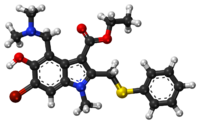Chemistry:Umifenovir
 | |
 | |
| Clinical data | |
|---|---|
| Trade names | Arbidol |
| Other names | AR-1I9514 |
| Pregnancy category |
|
| Routes of administration | By mouth (hard capsules, tablets) |
| ATC code | |
| Legal status | |
| Legal status | |
| Pharmacokinetic data | |
| Bioavailability | 40% |
| Metabolism | Hepatic, CYP3A4[4] |
| Elimination half-life | 17–21 hours |
| Excretion | 40% excrete as unchanged umifenovir in feces (38.9%) and urine (0.12%)[3] |
| Identifiers | |
| |
| CAS Number | |
| PubChem CID | |
| DrugBank | |
| ChemSpider | |
| UNII | |
| KEGG | |
| ChEBI | |
| ChEMBL | |
| PDB ligand | |
| Chemical and physical data | |
| Formula | C22H25BrN2O3S |
| Molar mass | 477.42 g·mol−1 |
| 3D model (JSmol) | |
| |
| |
| | |
Umifenovir, sold under the brand name Arbidol, is an antiviral medication for the treatment of influenza and COVID infections used in Russia [5] and China . The drug is manufactured by Pharmstandard (Russian: Фармстандарт). It is not approved by the U.S. Food and Drug Administration (FDA) for the treatment or prevention of influenza.[6]
Chemically, umifenovir features an indole core, functionalized at all but one positions with different substituents. The drug has been shown in studies to inhibit viral entry into target cells [7] and stimulate the immune response.
Status
Testing of umifenovir's efficacy has mainly occurred in China and Russia,[8][9] and it is well known in these two countries.[10] Some of the Russian tests showed the drug to be effective[8] and a direct comparison with oseltamivir showed similar efficiency in vitro and in a clinical setting.[11] In 2010 Arbidol was the drug brand with the highest sales volume in Russia.[12] In the first quarter of 2020 it had a 16 percent share in the Russian antiviral market.[13]
Mode of action
Biochemistry
Umifenovir inhibits membrane fusion of influenza virus.[5] Umifenovir prevents contact between the virus and target host cells. Fusion between the viral envelope (surrounding the viral capsid) and the cell membrane of the target cell is inhibited. This prevents viral entry to the target cell, and therefore protects it from infection.[14]
Some evidence suggests that the drug's actions are more effective at preventing infections from RNA viruses than infections from DNA viruses.[15]
As well as specific antiviral action against both influenza A and influenza B viruses, umifenovir exhibits modulatory effects on the immune system. The drug stimulates a humoral immune response, induces interferon-production, and stimulates the phagocytic function of macrophages.[16]
Clinical application
thumb|A Russian packet of Arbidol capsules Umifenovir is used primarily as an antiviral treatment for influenza. The drug has also been investigated as a candidate drug for treatment of hepatitis C.[17]
More recent studies indicate that umifenovir also has in vitro effectiveness at preventing entry of Zaire ebolavirus (Kikwit strain), Tacaribe arenavirus and Kaposi's sarcoma-associated herpesvirus in mammalian cell cultures, while confirming umifenovir's suppressive effect in vitro on Hepatitis B and poliovirus infection of mammalian cells when introduced either in advance of viral infection or during infection.[18][19]
Side effects
Side effects in children include sensitization to the drug. No known overdose cases have been reported and allergic reactions are limited to people with hypersensitivity. The -1">50 is more than 4 g/kg.[20]
Criticism
In 2007, the Russian Academy of Medical Sciences stated that the effects of Arbidol (umifenovir) are not scientifically proven.[21]
Russian media criticized lobbying attempts by Tatyana Golikova (then-Minister of Healthcare) to promote umifenovir,[22] and the unsubstantiated claim that Arbidol can speed up recovery from flu or cold by 1.3-2.3 days.[23] They also made claims that comparative clinical studies have proven umifenovir to be inefficient.[24][25]
Names
Arbidol is the INN.[26]
The brand name Arbidol is known as Russian: Арбидол and Chinese: 阿比朵尔.[citation needed]
Research
In early 2020 umifenovir was touted as a potential treatment for COVID-19 in China, where it was sometimes given to patients in combination with other drugs such as the anti-HIV drug Darunavir.[27][28][29][30] A three-arm RCT study published in May 2020 in the Cell Press journal Clinical Advances found that neither Umifenovir or Lopinavir/Ritonavir helped patients with mild to moderate COVID-19.[31] A similar study comparing Umifenovir directly with Lopinavir/Ritonavir found no difference in fever duration between the two groups but found a lower viral load on day 14 in the Umifenovir group.[32] A systemic review and meta-analysis of 16 studies on Umifenovir published in March 2021 concluded that there is "no significant benefit of using Arbidol compared with non‐antiviral treatment or other therapeutic agents against COVID‐19 disease."[33]
References
- ↑ 1.0 1.1 "阿比朵尔抑制新冠,先声药业生产的吗?" (in zh). http://www.qm120.com/tags/116282.htm.
- ↑ "ИНСТРУКЦИЯ ПО ПРИМЕНЕНИЮ АРПЕТОЛ (ARPETOL)" (in be). https://www.vidal.by/poisk_preparatov/arpetol.html.
- ↑ "Full Prescribing Information: Arbidol (umifenovir) film-coated tablets 50 and 100 mg: Corrections and Additions" (in ru). Open joint-stock company "Pharmstandard-Tomskchempharm". http://grls.rosminzdrav.ru/InstrImgMZ.aspx?regNr=ЛСР-003900/07&page=2.[yes|permanent dead link|dead link}}]
- ↑ "Pharmacokinetics, metabolism, and excretion of the antiviral drug arbidol in humans". Antimicrobial Agents and Chemotherapy 57 (4): 1743–1755. April 2013. doi:10.1128/AAC.02282-12. PMID 23357765.
- ↑ 5.0 5.1 "Characteristics of arbidol-resistant mutants of influenza virus: implications for the mechanism of anti-influenza action of arbidol". Antiviral Research 81 (2): 132–140. February 2009. doi:10.1016/j.antiviral.2008.10.009. PMID 19028526.
- ↑ "FDA Approved Drugs for Influenza". U.S. Food and Drug Administration. 8 December 2022. https://www.fda.gov/drugs/information-drug-class/influenza-flu-antiviral-drugs-and-related-information#ApprovedDrugs.
- ↑ "Structural basis of influenza virus fusion inhibition by the antiviral drug Arbidol". Proceedings of the National Academy of Sciences of the United States of America 114 (2): 206–214. January 2017. doi:10.1073/pnas.1617020114. PMID 28003465. Bibcode: 2017PNAS..114..206K.
- ↑ 8.0 8.1 "[Sensitivity of various influenza virus strains to arbidol. Influence of arbidol combination with different antiviral drugs on reproduction of influenza virus A"]. Terapevticheskii Arkhiv (ИЗДАТЕЛЬСТВО "МЕДИЦИНА") 77 (8): 84–88. 2005. PMID 16206613. http://arbidol.org/arbidol-2005-works-as-well.html.
- ↑ "[Efficacy and safety of arbidol in treatment of naturally acquired influenza]". Zhongguo Yi Xue Ke Xue Yuan Xue Bao. Acta Academiae Medicinae Sinicae 26 (3): 289–293. June 2004. PMID 15266832.
- ↑ "Arbidol: a broad-spectrum antiviral compound that blocks viral fusion". Current Medicinal Chemistry 15 (10): 997–1005. 2008. doi:10.2174/092986708784049658. PMID 18393857.
- ↑ "Virus susceptibility and clinical effectiveness of anti-influenza drugs during the 2010-2011 influenza season in Russia". International Journal of Infectious Diseases 43: 77–84. February 2016. doi:10.1016/j.ijid.2016.01.001. PMID 26775570.
- ↑ "Russian Pharmaceutical Market 2010". DSM Group. https://www.dsm.ru/docs/analytics/farmrinok_roccii_itogi_2010_eng.pdf.
- ↑ "Most popular antiviral medication brands in the Russian pharmaceutical market in 1st quarter 2020 by sales value share". https://www.statista.com/statistics/1123149/sales-value-share-of-leading-antiviral-brands-russia/.
- ↑ "Arbidol: a broad-spectrum antiviral that inhibits acute and chronic HCV infection". Virology Journal 3: 56. July 2006. doi:10.1186/1743-422X-3-56. PMID 16854226.
- ↑ "Antiviral activity of arbidol against influenza A virus, respiratory syncytial virus, rhinovirus, coxsackie virus and adenovirus in vitro and in vivo". Archives of Virology 152 (8): 1447–1455. 2007. doi:10.1007/s00705-007-0974-5. PMID 17497238.
- ↑ "[Mechanisms of arbidole's immunomodulating action]" (in ru). Vestnik Rossiiskoi Akademii Meditsinskikh Nauk (3): 36–40. 1999. PMID 10222830.
- ↑ "Biochemical mechanism of hepatitis C virus inhibition by the broad-spectrum antiviral arbidol". Biochemistry 46 (20): 6050–6059. May 2007. doi:10.1021/bi700181j. PMID 17455911.
- ↑ "The Synthetic Antiviral Drug Arbidol Inhibits Globally Prevalent Pathogenic Viruses". Journal of Virology 90 (6): 3086–3092. January 2016. doi:10.1128/JVI.02077-15. PMID 26739045.
- ↑ "Arbidol and Other Low-Molecular-Weight Drugs That Inhibit Lassa and Ebola Viruses". Journal of Virology 93 (8). April 2019. doi:10.1128/JVI.02185-18. PMID 30700611.
- ↑ "АРБИДОЛ (ARBIDOL)". Vidal. http://www.vidal.ru/poisk_preparatov/arbidol.htm.
- ↑ "Resolution". Meetings of the Presidium of the Formulary Committee. Russian Academy of Medical Sciences. 16 March 2007. http://www.rspor.ru/mods/news/docs/Resolution_Formulary_committee_meeting_16.03.%202007.doc.
- ↑ "How do we plant federal ministers" (in ru). MKRU. 21 April 2011. https://www.mk.ru/politics/2011/04/21/583254-kak-nam-posadit-federalnyih-ministrov.html.
- ↑ "13 most popular flu cures: do they work?" (in ru). Professional Journalism Platform. 23 December 2013. https://republic.ru/posts/l/1037105#1.%20%D0%90%D0%A0%D0%91%D0%98%D0%94%D0%9E%D0%9B.%20%D0%9E%D0%B1%D1%8A%D0%B5%D0%BC%20%D0%BF%D1%80%D0%BE%D0%B4%D0%B0%D0%B6%20-%205%20%D0%BC%D0%BB%D1%80%D0%B4%20%D1%80%D1%83%D0%B1.
- ↑ "Палка в колеса" (in ru). Esquire. https://esquire.ru/archive/1880-drugs/#part0.
- ↑ "Повторение — мать учения" (in ru). Esquire. https://esquire.ru/archive/2047-arbidol-2/#part0.
- ↑ Recommended INN: List 65., WHO Drug Information, Vol. 25, No. 1, 2011, page 91
- ↑ "Coronavirus: are cocktail therapies for flu and HIV the magic cure?". South China Morning Post. 4 February 2020. https://www.scmp.com/business/companies/article/3048888/could-cocktail-therapies-hiv-and-flu-be-magic-cure-new. "Bangkok and Hangzhou hospitals put combination remedies to the test."
- ↑ "China's health officials say priority is to stop mild coronavirus cases from getting worse.". South China Morning Post. 4 February 2020. https://www.scmp.com/news/china/society/article/3048993/chinese-officials-say-priority-stop-mild-coronavirus-cases.
- ↑ "Drug treatment options for the 2019-new coronavirus (2019-nCoV)". BioScience Trends 14 (1): 69–71. March 2020. doi:10.5582/bst.2020.01020. PMID 31996494.
- ↑ "Efficacies of lopinavir/ritonavir and arbidol in the treatment of novel coronavirus pneumonia" (in zh). Chinese Journal of Infectious Diseases 38: E008. 2020-02-21. doi:10.3760/cma.j.cn311365-20200210-00050. ISSN 1000-6680. http://rs.yiigle.com/yufabiao/1182592.htm.
- ↑ "Efficacy and Safety of Lopinavir/Ritonavir or Arbidol in Adult Patients with Mild/Moderate COVID-19: An Exploratory Randomized Controlled Trial". Med 1 (1): 105–113.e4. December 2020. doi:10.1016/j.medj.2020.04.001. PMID 32838353.
- ↑ "Arbidol monotherapy is superior to lopinavir/ritonavir in treating COVID-19". The Journal of Infection 81 (1): e21–e23. July 2020. doi:10.1016/j.jinf.2020.03.060. PMID 32283143.
- ↑ "Efficacy and safety of arbidol (umifenovir) in patients with COVID-19: A systematic review and meta-analysis". Immunity, Inflammation and Disease 9 (4): 1197–1208. December 2021. doi:10.1002/iid3.502. PMID 34347937.
External links
- "Umifenovir". Drug Information Portal. U.S. National Library of Medicine. https://druginfo.nlm.nih.gov/drugportal/name/umifenovir.
 |

